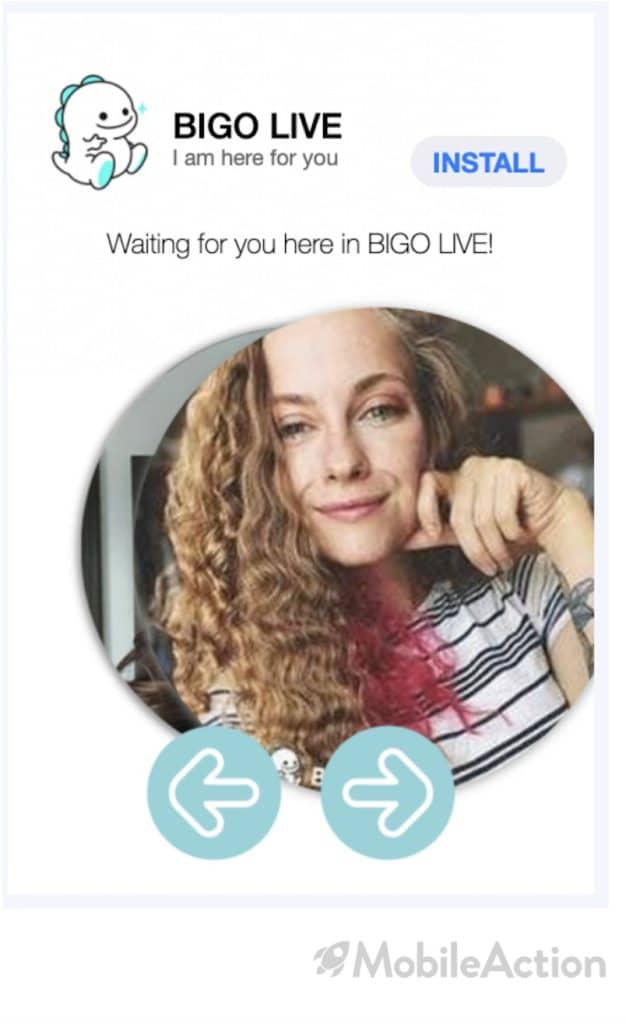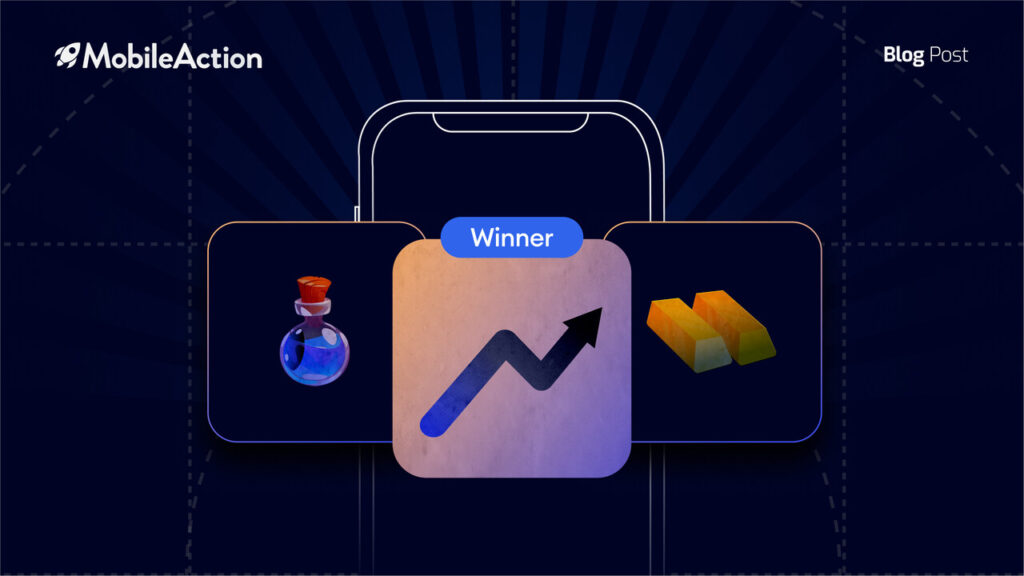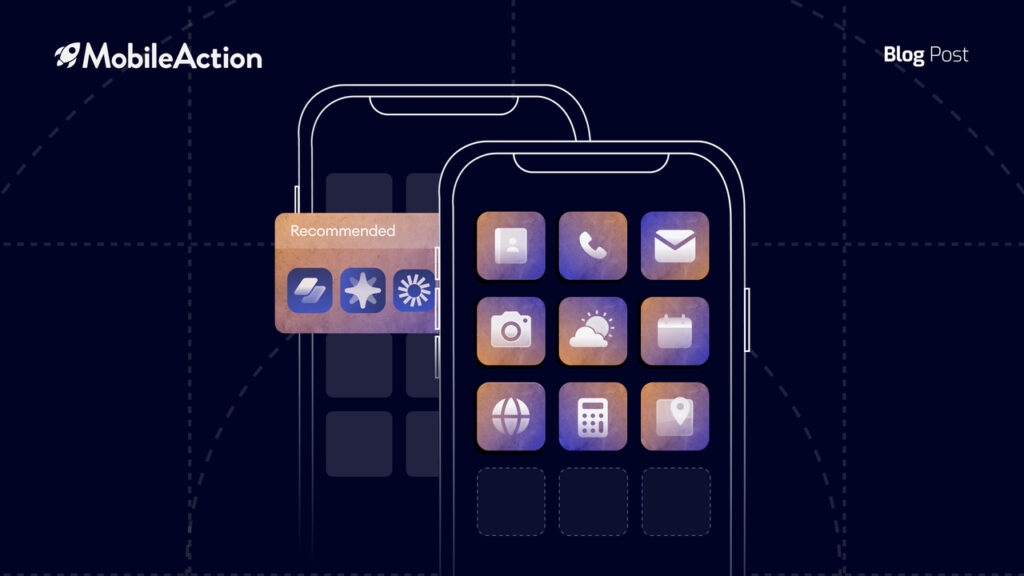Most of us have probably heard about TikTok, the app that spread like wildfire from China to the entire world. Tiktok has been dominating the app markets for a long time. Well, have you heard about Bigo Live? For this edition of our ad analysis posts, we have chosen Bigo Live and took a closer look at their advertisement strategies.
Placing under the Social Apps category, Bigo Live has been increasing its downloads steadily since the start of 2020. Bigo Live allows its users to live-stream their lives or share vlogs. It is also possible for creators on this platform to earn money.
With an incredibly aggressive advertising strategy, they have been increasing their popularity in the app world. With their interesting creatives, not-so-positive reviews, and ever-increasing active users, Bigo Live definitely is a curious case. Let’s investigate the steps of Bigo Live to uncover the story behind their success. Welcome to the ad analysis of Bigo Live.
Category Rankings
The category rankings section of Mobile Action’s App Intelligence tool enables us to get a broad look into Bigo Live’s success in 2020. Social Networking is a very competitive category as it includes apps such as WhatsApp, Zoom, and Facebook. As you can expect, ranking in this category is not an easy feat.
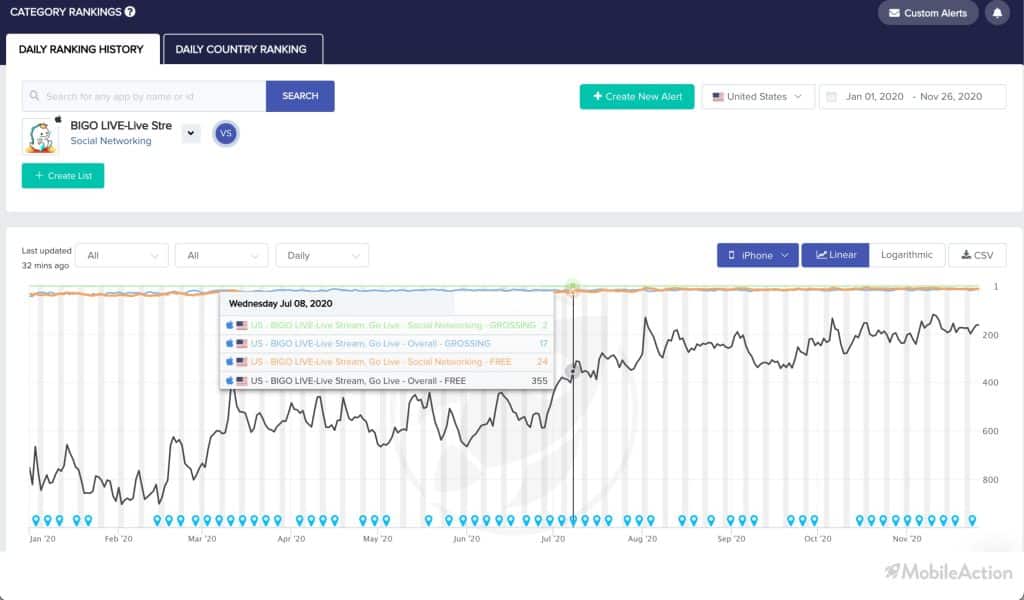
Even though they have been defending their position as the first ranking grossing Social Networking app for some time, their overall ranking in the App Store has increased from 800 to almost 150, proving the effectiveness of their advertising strategies. They are currently ranking as the 14th app in the free Social Networking category. How can we explain this rather dramatic increase in Bigo Lives’s overall rankings? Mobile Action’s Ad Intelligence provides us with the tools we need to understand Bigo Live’s strategy.
Top Advertisers
The Top Advertisers tool under Ad Intelligence allows us to see advertisers who are dominating the ad networks. We can gather insights about the competitiveness of certain apps and their commitment to a paid growth strategy. When we investigate the top advertisers in the app store, we get a glimpse of Bigo Live’s aggressive ad strategy that they implemented in 2020.
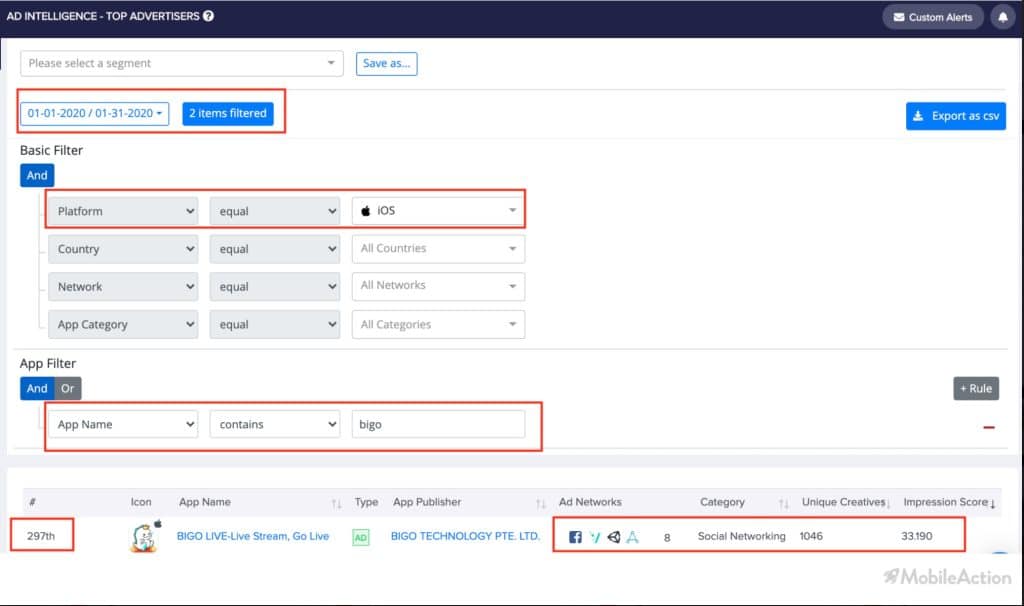
Here we can use filters to specify time intervals, platforms, ad networks and more. When we filter our results for the first month of 2020 in the App Store, some key metrics appear. The difference is astounding when we compare these numbers to current data for Bigo Live.
In January 2020, Bigo Live was the 297th top advertiser with a total of 1046 creatives and 8 ad networks. Now let’s look at their current numbers to appreciate their dedication to advertising in 2020.

Currently, Bigo Live is the 11th top advertiser on all of the App Store. They also currently rank 9th on the Google Play Store. Now, maybe 11th place might not seem like such an impressive number for you, so I invite you to look at the table one more time. As you can see, every other app on the list is a game. Apps in the gaming category normally pursue much more aggressive tactics compared to other categories. Thus we are used to seeing the Top Advertisers list dominated by them.
As Bigo Live is the only app in this table that does not belong to the Games category, naturally they are the top advertiser in the Social Networking category, surpassing its competitors with a big margin.
I suppose we can agree on the fact that Bigo Live is indeed pursuing a high-budget aggressive ad campaign. Now let’s dive into our Campaign Analysis, where we can analyze this campaign in more detail.
Campaign Analysis
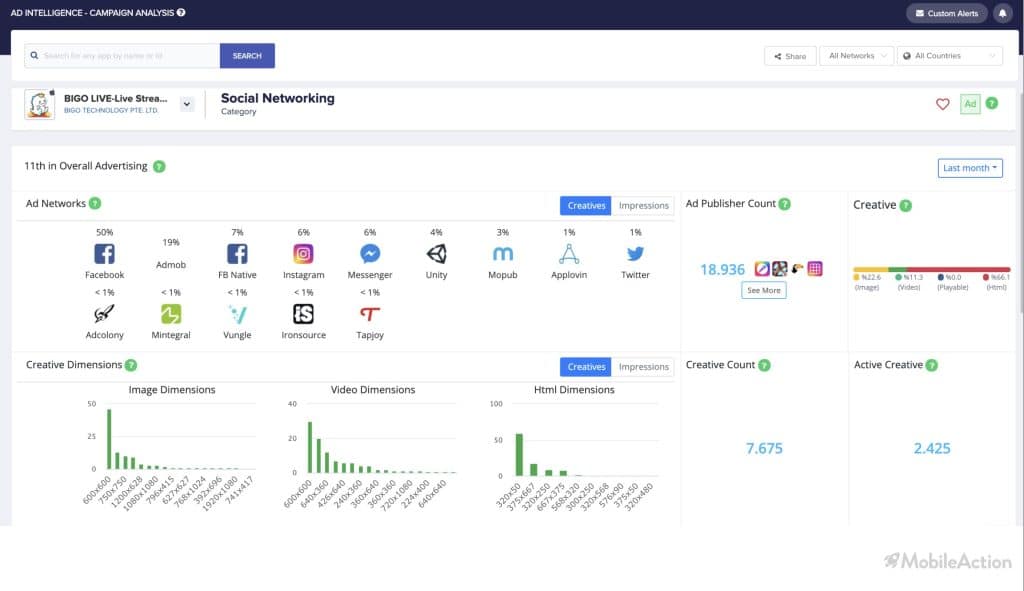
First of all, we can see that Bigo Live is currently running ads on 14 ad networks. Compared to 11 in January, this increase in ad networks is yet another indication of their aggressive strategies. They are mostly using Facebook to run their ads, where almost half of their campaign takes place. Following Facebook, with a 20% share, AdMob seems to be another important ad network for Bigo Live.
They are using nearly 19,000 apps to publish their ads, which is a huge amount. To put things into perspective, their competitor TikTok uses approximately half that amount. They have used a total of 7,675 creatives until now and 2,425 of them are actively being used. Even though this might not seem like a very efficient use of creatives, it is similar to their competitors such as TikTok. It can be expected for these kinds of apps to produce lots of creatives in order to experiment with their material and find out efficient ones through A/B testing to get maximum efficiency.
When we look at the types of creatives, we can see that they mostly use HTML creatives (66.1%). This kind of creative distribution is normal for the category and similar to the strategy used by Tiktok.
Interestingly, even though Facebook seems to be the primary ad network of choice for Bigo Live, it appears that it is not very efficient in terms of the impression scores that we have calculated.
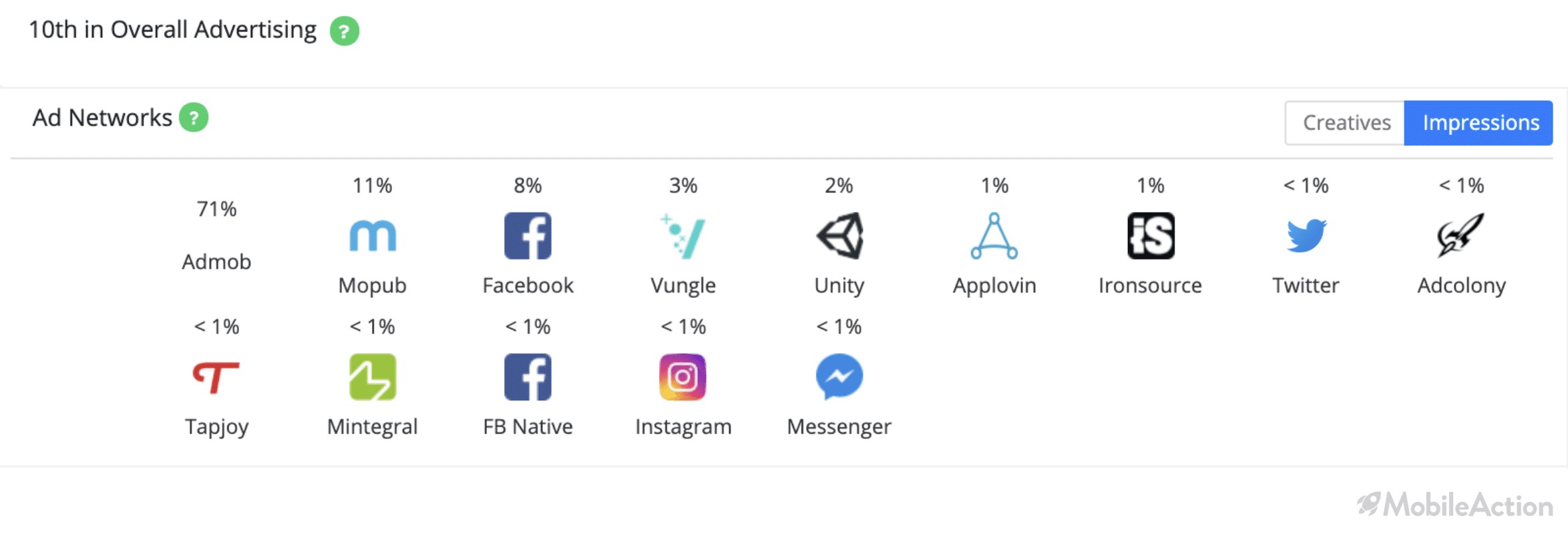
Even though Admob had only 19% of the creatives, it appears that it has brought in more than 71% of the total estimated impressions, which is a very impressive number. Following Admob, Mopub and Facebook seem to be bringing in the most impressions according to their impression scores.
Localization

In the Campaign Analysis tab, we can also see if an app is trying to localize their efforts or if there are widespread and using a balanced creative strategy. Bigo Live seems to put a little more emphasis on the United States and Japan in their ad campaign compared to other locations. The rest of the countries seem to have almost equal amounts of exposure to these ads with values ranging from 1% to 2%. Especially for a Video Streaming/Vlogging kind of app, it is a reasonable approach as people in different areas of the world can enjoy each other’s videos, regardless of language differences. By almost equally distributing their efforts, Bigo Live seems to have considered every single person to be a potential user. Their assumption seems to have worked for them.

When we look at the Impressions panel, we observe some inequality in distribution. As Japan was one of the two targeted countries, it is understandable that they are generating a large chunk of total estimated impressions. However, Korea, Viet Nam, and Turkey seem to dominate other countries in terms of the impression scores that we have calculated even though they were not specifically targeted.
Even though Bigo Live probably welcomed their unexpected potential customers with open arms, there is something to think about here. Although the United States appeared as their primary target, only 5% of their estimated impressions came from the country. This means that there can be possible improvements in their campaign in the U.S to increase their influence on the market. Or they can move their efforts from inefficient markets to countries such as Korea to get the best ROAS.
Creative Analysis
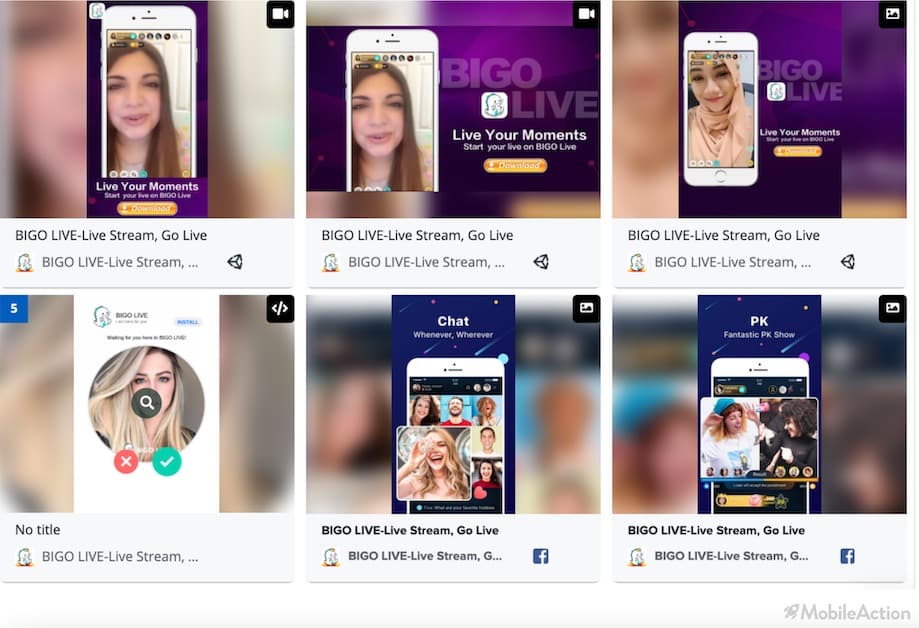
With the Top Creatives tool, we can view the most successful creatives of an app. Bigo Live has a cute mascot as its symbol and seems very inviting to people of all ages. However, on their website they claim that the app has an age limit of 18. It might seem contradictory for an app that appears to be suitable for all ages to have an age limit. However, this is yet another smart move by their UA managers. They have an entire page dedicated to explaining how their app is different from TikTok. You can see that they have created a selling point out of the fact that the TikTok user base is very immature while Bigo Live is not limited to young people.
When we inspect some of these creatives, we can also see that some of their material is very similar to a Tinder-like interface design even though the app itself has nothing to do with dating. These kinds of creatives might be one of the driving factors behind the negative reviews that we will look at shortly.
If you follow our blog, you might have read our post on Misleading Ad Strategies, where we took a look at Gardenscapes, an app infamous for its creatives which have nothing to do with the app itself. Bigo Live might have employed similar techniques to increase its reach. They are using very interesting creatives in order to capture the attention of potential users, and this strategy clearly seems to be working.
User Reviews

The reviews tab in App Intelligence provides us with an overview of the user feedback regarding an application. Bigo Live seems to be getting a lot of 1-star reviews. People are complaining about the community, the user experience, and lots of other things.
Now the title of this blog post was the Curious Case of Bigo. I want to add one last interesting graph to rest my case. Despite the negative reviews, Bigo Live managed to increase its daily users by a drastic amount, which is indicative of a successful advertising strategy. With Mobile Action’s Market Intelligence tool, let’s take a look at Bigo Live’s estimated daily active users.
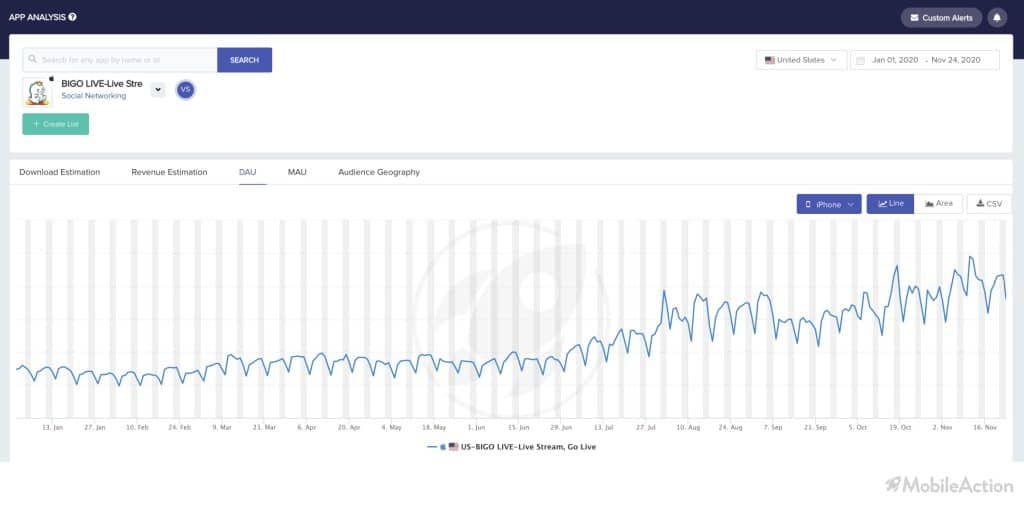
How does an app increase its daily active users by almost 4 times with an unsatisfied user base? Two explanations come to mind. Either the users are experiencing a kind of Stockholm Syndrome where they love and hate the app at the same time or, more logically, the aggressive and strategic advertisement campaign of the app is drawing in so many new users that people deleting the app is not even important anymore. Kudos to Bigo Live. What a campaign!
Verdict
It has been a fascinating ad analysis. Interesting ads, bad reviews, increasing users, and unbelievable amounts of advertising. The key takeaway of this post should be the power of strategic advertising. You might not have the best app or you might not have the biggest fan base. But still, you can draw in incredible amounts of users through a creative strategy in advertising.
You can use all the tools we have shown here today and more to discover new strategies and implement them in your own business plan. Schedule a demo with us and let us guide you to success in the mobile app market!
